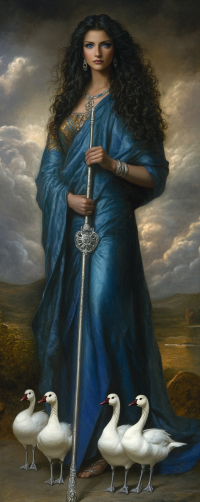Parkia
Goddess of the Sky and the night, mother of sky gods, and wife to Sun God Amrulon, Parkia is a powerful divinity worshiped under various names throughout the world. To the ancient Pallathantic and Ithatian Tribes, she was the goddess Pallatha. The Pallathantic Sea was named after her because its surface reflected the the face of the sky. She is mother to many sky gods and divinities, including Parkulliam (Kiall, Parkyo), Thwar (Azephassus), Threy (Kirxios), Palithreeta (Goddess of Starmoon), and Bralla (Goddess of Sunmoon). Her cult is ancient and she is beloved among the sky tribes and elsewhere throughout the world. Some modern scholars theorize that Parkia is combination of an Isxinthion and a High Shadevan divinity. The cult of the sky goddess of Tiambrib, Thrace, is attested to at least the sixth century before Salmakhamer. Parkia is very important among the traditional religion of the sky people and the Religion of Thwar.
Divine Sphere of Influence
Parkia presides over women in the wedded state. She is goddess of marriage and of domestic duties, particularly the weaving of the loom. Among the ancient sky tribes, the women of the household wove the fibers that became the magical sails of the skycraft by which the sky tribesmen could herd gontha and fight their enemies. The loom holds great significance in traditional skyfaring culture as the source of skysails for the skycraft that are essential for herding gontha, warfare, and commerce.
Divine Attributes
Parkia is Queen of the Heavens and one of the Elder Isxinthion gods. She is known for mercy and fits of outrage when her sense of goodness is offended. She is not characterized by lightning, but by rains of all sorts and soft thunder rumbling in the distance.
Depictions of Parkia
Parkia is depicted as a tall woman with brown or dark hair with crystal blue eyes. She wears a long, dark blue robe, often intense, dark royal blue and stands upon a field of sparkling stars.
Associated Animal
Her beast is the goose or the duck, depending upon the region and her priestesses attribute the flight of the dove as one of her omens.
See Also
| This article is a stub. It requires further development by the creator. |
